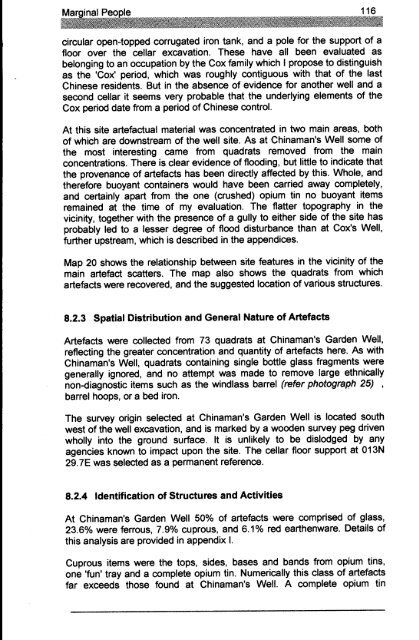Adec Preview Generated PDF File - The Sydney eScholarship ...
Adec Preview Generated PDF File - The Sydney eScholarship ...
Adec Preview Generated PDF File - The Sydney eScholarship ...
You also want an ePaper? Increase the reach of your titles
YUMPU automatically turns print PDFs into web optimized ePapers that Google loves.
circular open-topped corrugated iron tank, and a pole for the support of a<br />
floor over the cellar excavation. <strong>The</strong>se have all been evaluated as<br />
belonging to an occupation by the Cox family which I propose to distinguish<br />
as the 'Cox' period, which was roughly contiguous with that of the last<br />
Chinese residents. But in the absence of evidence for another well and a<br />
second cellar it seems very probable that the underlying elements of the<br />
Cox period date from a period of Chinese control.<br />
At this site artefactual material was concentrated in two main areas, both<br />
of which are downstream of the well site. As at Chinaman's Well some of<br />
the most interesting came from quadrats removed from the main<br />
concentrations. <strong>The</strong>re is clear evidence of flooding, but little to indicate that<br />
the provenance of artefacts has been directly affected by this. Whole, and<br />
therefore buoyant containers would have been carried away completely,<br />
and certainly apart from the one (crushed) opium tin no buoyant items<br />
remained at the time of my evaluation. <strong>The</strong> flatter topography in the<br />
vicinity, together with the presence of a gully to either side of the site has<br />
probably led to a lesser degree of flood disturbance than at Cox's Well,<br />
further upstream, which is described in the appendices.<br />
Map 20 shows the relationship between site features in the vicinity of the<br />
main artefact scatters. <strong>The</strong> map also shows the quadrats from which<br />
artefacts were recovered, and the suggested location of various structures.<br />
8.2.3 Spatial Distribution and General Nature of Artefacts<br />
Artefacts were collected from 73 quadrats at Chinaman's Garden Well,<br />
reflecting the greater concentration and quantity of artefacts here. As with<br />
Chinaman's Well, quadrats containing single bottle glass fragments were<br />
generally ignored, and no attempt was made to remove large ethnically<br />
non-diagnostic items such as the windlass barrel (refer photograph 25) ,<br />
barrel hoops, or a bed iron.<br />
<strong>The</strong> survey origin selected at Chinaman's Garden Well is located south<br />
west of the well excavation, and is marked by a wooden survey peg driven<br />
wholly into the ground surface. It is unlikely to be dislodged by any<br />
agencies known to impact upon the site. <strong>The</strong> cellar floor support at 013N<br />
29.7E was selected as a permanent reference.<br />
8.2.4 Identification of Structures and Activities<br />
At Chinaman's Garden Well 50% of artefacts were comprised of glass,<br />
23.6% were ferrous, 7.9% cuprous, and 6.1% red earthenware. Details of<br />
this analysis are provided in appendix I.<br />
Cuprous items were the tops, sides, bases and bands from opium tins,<br />
one 'fun' tray and a complete opium tin. Numerically this class of artefacts<br />
far exceeds those found at Chinaman's Well. A complete opium tin




